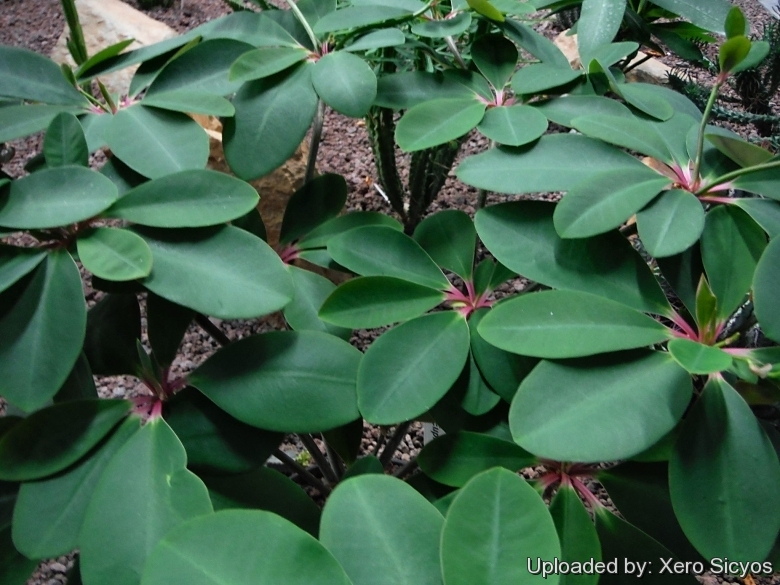




Your support is critical to our success.

Origin and Habitat: Euphorbia bongolavensisSN|33397]]SN|33397]] is s remarkable species known from only from the Bongolava area(south-east of Port-Bergé (Boriziny). North-western Madagascar. A new locality was found in the same area close to the Sofia river (NW Madagascar).
Habitat and Ecology: This species grows in humus between rocks within the dry, deciduous forest on the Bongolava mountains. The population occurring near the Sofia river grows in white sands. This species is threatened by habitat degradation, fire, habitat clearing for charcoal, collection for horticulture.
Synonyms:
Euphorbia bongolavensis Rauh
Kakteen Sukk. 44: 70 1993.
Synonymy: 2
Description: Euphorbia bongolavensis is a shrublet up to 1 metres tall, closely related to Euphorbia hedyotoides and Euphorbia umbraculiformis. All these peculiar plants are differentiated into an upright branchless stem and a much-branched, umbrella-like crown. The main stem stops elongating by the formation of brachyblasts (short, densely crowded shoots bearing clusters of leaves) that produce an umbrella like open crown. Though not really a succulent, but a very slow growing xerophyte, Euphorbia bongolavensis is a real must grown by succulent entusiasts. It has uniquely coloured leaves with bases of red and the rest of the lancelote shaped leaves a green to bluish green (depending on how much sun or shade). The stem resembles a commiphora or bursera with its peeling bark. The flowers are reduced in size and aggregated into a cluster of yellow flowers called a cyathium (plural cyathia).
Stem: Primary stem woody, spineless, 30-40 cm long, 4 cm in diameter, branchless below; bark pale gray, peeling off in rings; stem covered with round scars. Branches about 10 (often much more numerous), green, red-tipped, erect, forming a loose crown, falling when old, 3-5 mm thick. Each branch begins with a gray-green hypopodium to 30 cm long and further branching occurs after several years as in Euphorbia hedyotoides with swollen apical short-shoots, covered in densely arranged leaf-scars (brachyblasts) to 2 cm long.
Root: Tap root woody.
Leaves: 5 to 8 deciduous, sclustered at branches tip, spreading radially, like little umbrellas, lanceolate to ovate, narrowing to petiole, variable in size, to 6.5 cm long, 3.5 cm wide, dark green above with reddish highlights near the petioles, grey-green below, margins somewhat revolute (rolled), apex short acuminate. Petiole flattened, 0.5-1 cm long, bright carmine-red. Stipules very small, hardly visible, soon deciduous.
Flowers (cyathia): Female cyathia, solitary (rarely 2), subterminal, small, to 2mm in diameter; subsessile. Glands erect, concave, small, yellow; involucral bracts deeply dentate at tip, green; bracteoles present, fimbriate, white; cyathophylls erect, carinate, enveloping involucre, pale-red, sharply acute. Ovary globular, not furrowed, green, glabrous, subsessile. Styles shortly joined at base, thick, strongly curved back, bifid. Male cyathia 3-4 clustered .
Fruits: Obtusely lobed, 7 x 5 mm on short pedicels (2 mm long).
Seeds: Globose , 1.5 mm in diameter.
Subspecies, varieties, forms and cultivars of plants belonging to the Euphorbia bongolavensis group
 Euphorbia bongolavensis Rauh: has upright branchless stem and a much-branched, umbrella-like crown. The main stem stops elongating by the formation of brachyblasts. Distribution: Bongolava area. N-W Madagascar.
Euphorbia bongolavensis Rauh: has upright branchless stem and a much-branched, umbrella-like crown. The main stem stops elongating by the formation of brachyblasts. Distribution: Bongolava area. N-W Madagascar.  Euphorbia bongolavensis f. variegata hort.: variegated form with beautiful leaves that have sectors, patches or stripes with two colours, creamy-yellow and bright bluish-green.
Euphorbia bongolavensis f. variegata hort.: variegated form with beautiful leaves that have sectors, patches or stripes with two colours, creamy-yellow and bright bluish-green.
Bibliography: Major references and further lectures
1) Werner Rauh, Herman Schwartz “Succulent and xerophytic plants of Madagascar” Volume 2 Pag. 154 – 1998
2) The Euphorbia journal Strawberry Press, 1994
3) Haevermans, T. 2004. Euphorbia bongolavensis. The IUCN Red List of Threatened Species 2004: e.T44310A10888649. http://dx.doi.org/10.2305/IUCN.UK.2004.RLTS.T44310A10888649.en. Downloaded on 26 December 2016.
4) Rauh, W. “Euphorbia bongolavensis Rauh – Eine bemerkenswerte Art aus Westmadagascar.” Kakteen Sukkulenten 44(4): 70-75.1993
5) Urs Eggli “Illustrated Handbook of Succulent Plants: Dicotyledons” Volume 2. Springer, 2002
Cultivation and Propagation: Euphorbia bongolavensisSN|33397]]SN|33397]] seem to be a sub-xeric and grows quite well in partial shade. It loves more humid in soil mix than another xeric succulent Euphorbia.
propagation: The easier method to propagate is by cutting that can also be rooted in water.
| Your Actions | |
|---|---|
| Back to Euphorbia index | |
| Back to Euphorbiaceae index | |
 |
Back to Succulents Encyclopedia index |
Privacy stantement - Terms and conditions - How to cite - About us - Feedback - Donate



